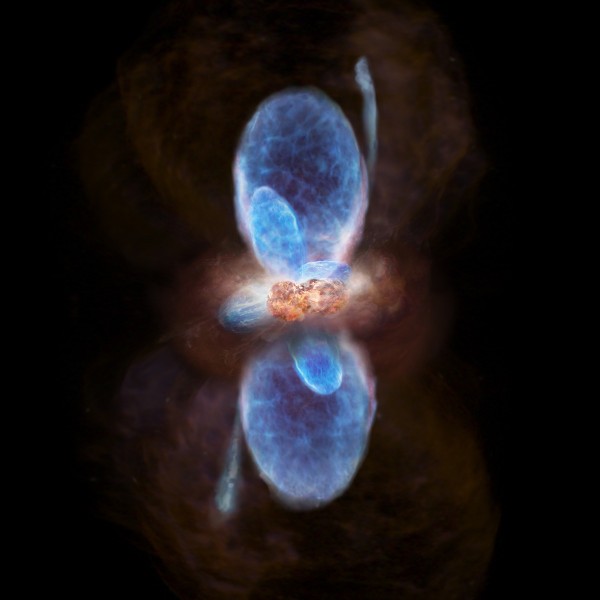Science
Related: About this forumGiant stars’ birth makes cosmic hourglass
Release Date: Sep 09, 2015
Giant stars’ birth makes cosmic hourglass
The birth throes of high-mass stars have been shrouded in mystery. While penetrating the mystery, astronomers working in Chile discovered a vast cosmic hourglass.

[font size=1]
Artist’s depiction of IRAS 16547-4247. Multiple young, high-mass stars are thought to reside in the center. Gas
pushes outward from these forming stars, creating a huge cosmic hourglass. Also, notice the pair of narrow jets,
found in past observations. Image via Alma Observatory
[/font]
New observations from Chile with the Atacama Large Millimeter/submillimeter Array – aka ALMA, which, by the way, is Spanish for soul and Arabic for learned or knowledgeable – have revealed multiple (at least two) gas outflows from a newly forming superstar (or maybe two superstars). The researchers have found what they say is a vivid hourglass structure, created by the gas flowing outward from the star-forming region. Such a detailed observation of this region of space is step forward for astronomers, who knew this region previously as a source of infrared radiation – discovered decades ago by the IRAS satellite and known as IRAS 16547-4247. The region is about 9,500 light-years away from Earth in the direction of the constellation Scorpius. It’s exciting because these are very detailed observations of a region where high-mass stars are forming. In the past, the birth throes of high-mass stars have mostly been shrouded in mystery.
We know that stars vary widely in mass, but the study of the formation of high-mass stars has been difficult, partly because these stars are extravagant spenders of the internal nuclear fuel that enables stars to shine. Thus, they don’t live very long, and so there are fewer high-mass stars near us in space. Even the closest known region of high-mass star formation is 1,500 light-years away, in the Orion Nebula.
What’s more, according to a statement from ALMA this week, it’s thought that high-mass stars are born in clusters with multiple stars forming together. So you can imagine high-mass star birth going on in distant and complex regions, shrouded with the gas and dust from which new stars are made.
Located in the Atacama desert of northern Chile, ALMA is relatively new telescope, whose scientific observations began in 2011. These astronomers noted:
… ALMA is the most desirable telescope for this purpose as being capable of observing gas and dust, (the) ingredients of stars, at high sensitivity and high resolution.
More:
http://earthsky.org/space/giant-stars-birth-makes-cosmic-hourglass
Statistical
(19,264 posts)I know it is crazy because it won't happen for hundreds of billions of years. I guess we should enjoy the show while it lasts.